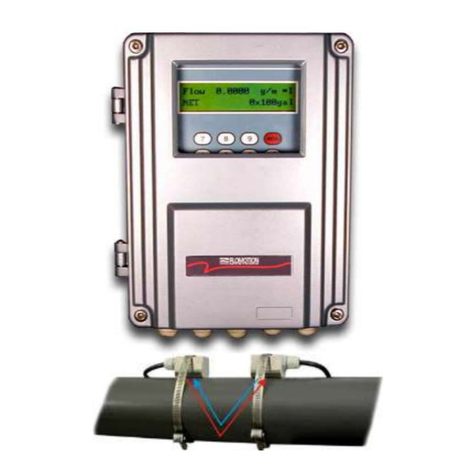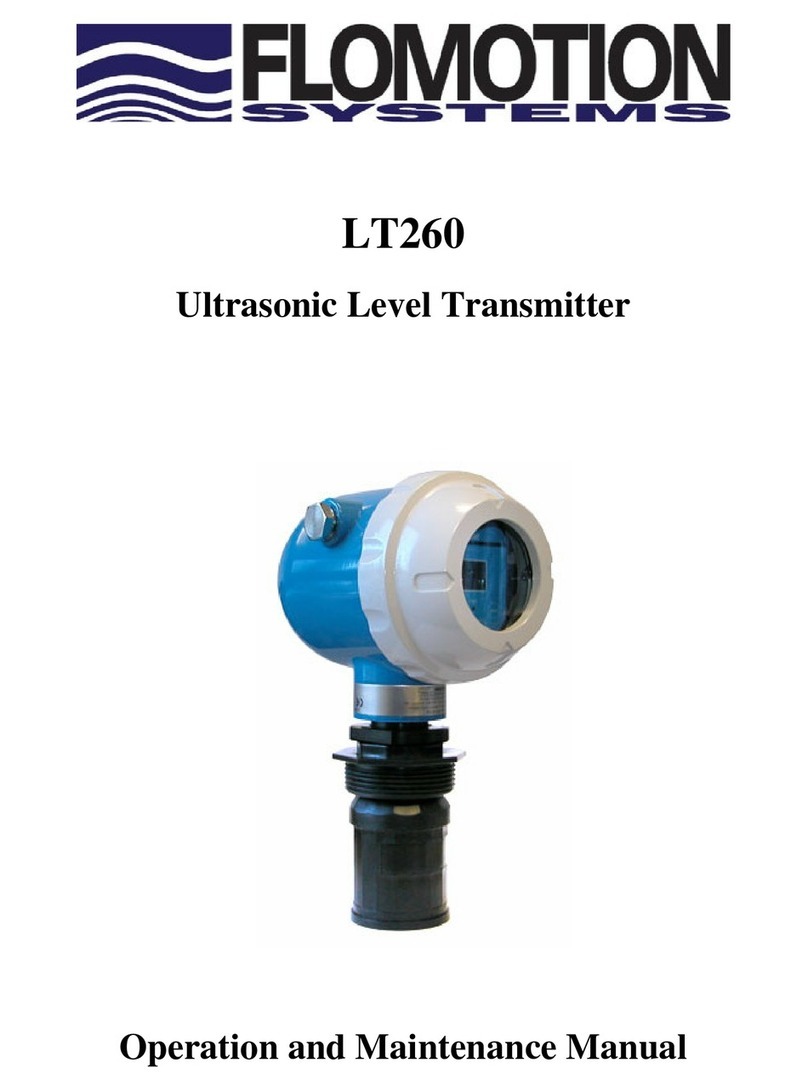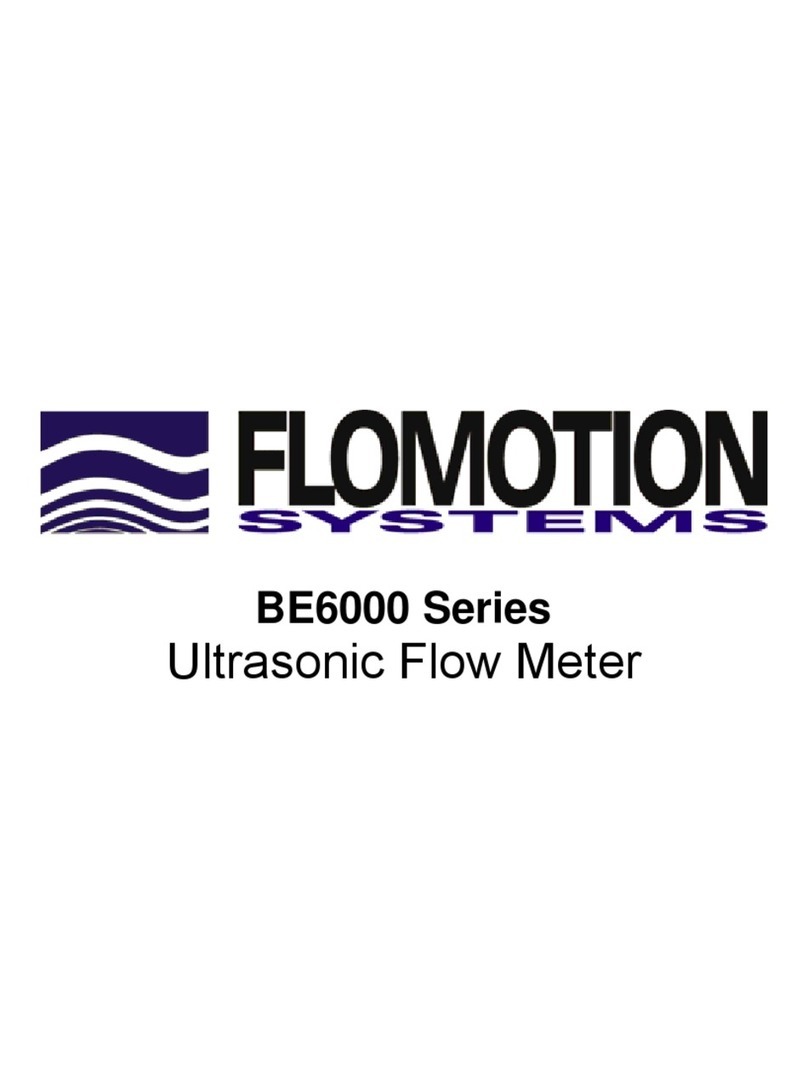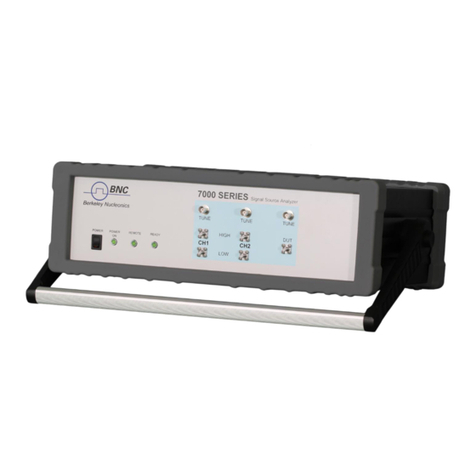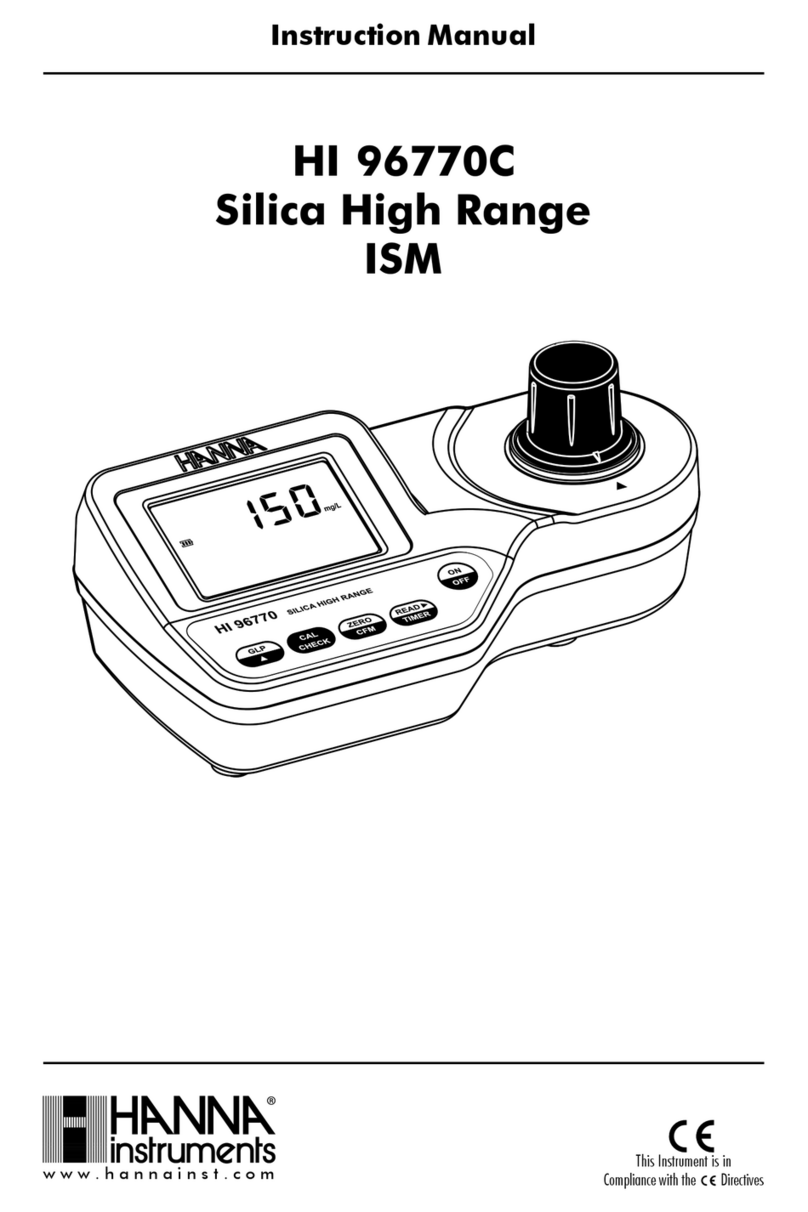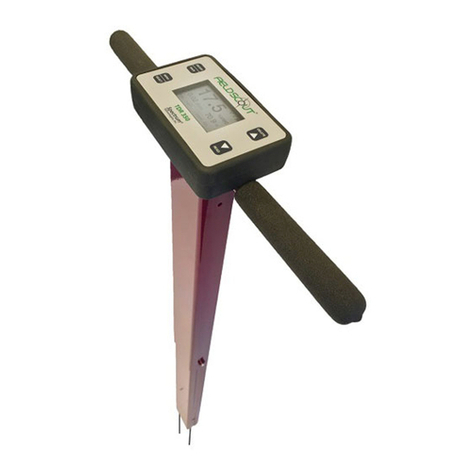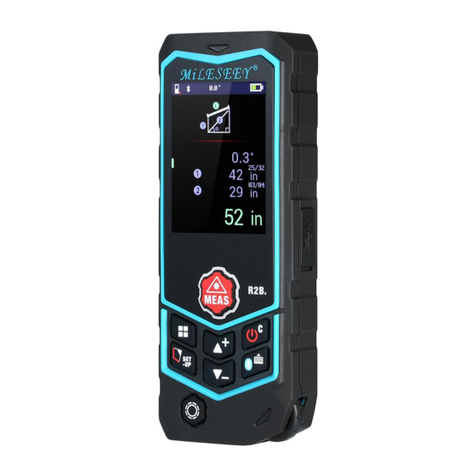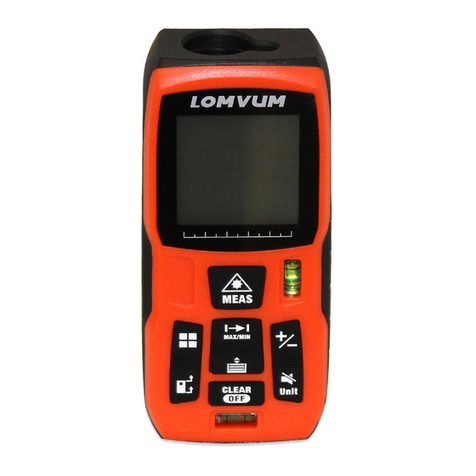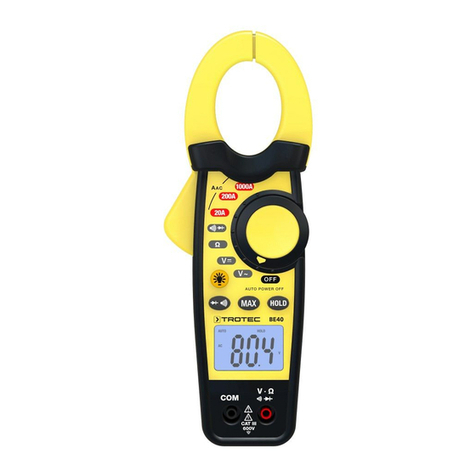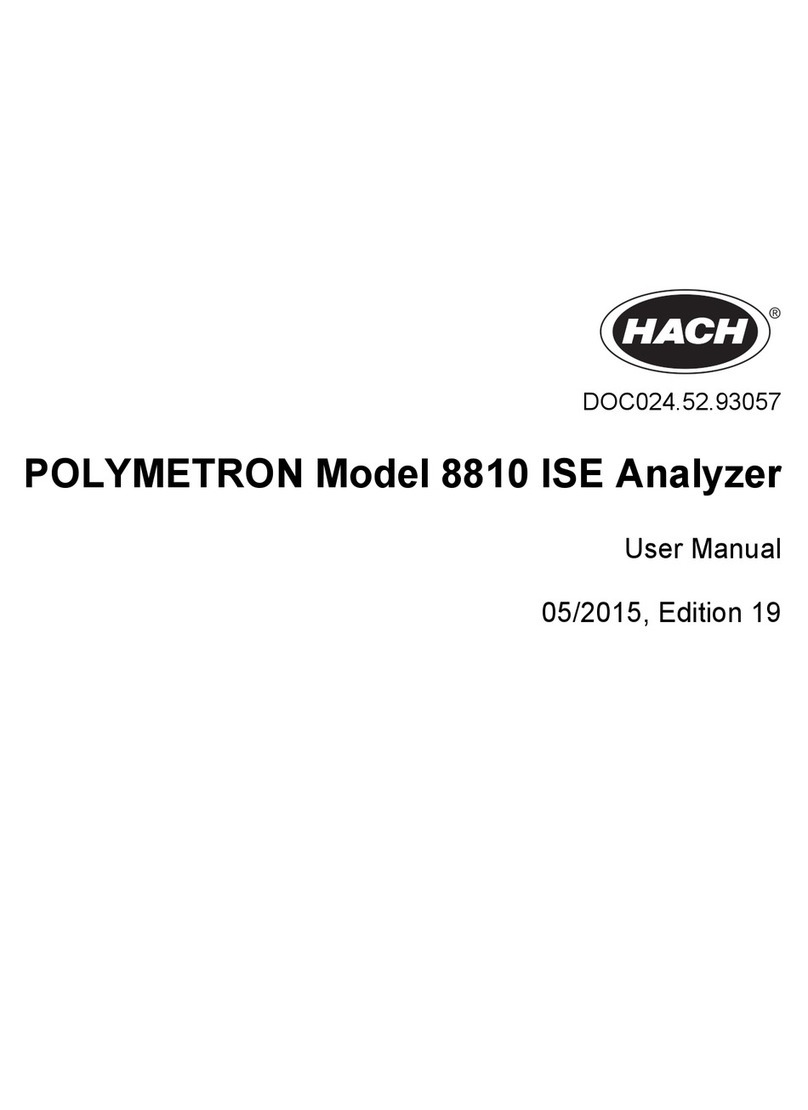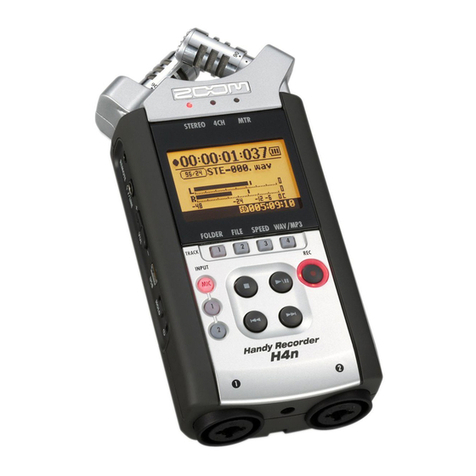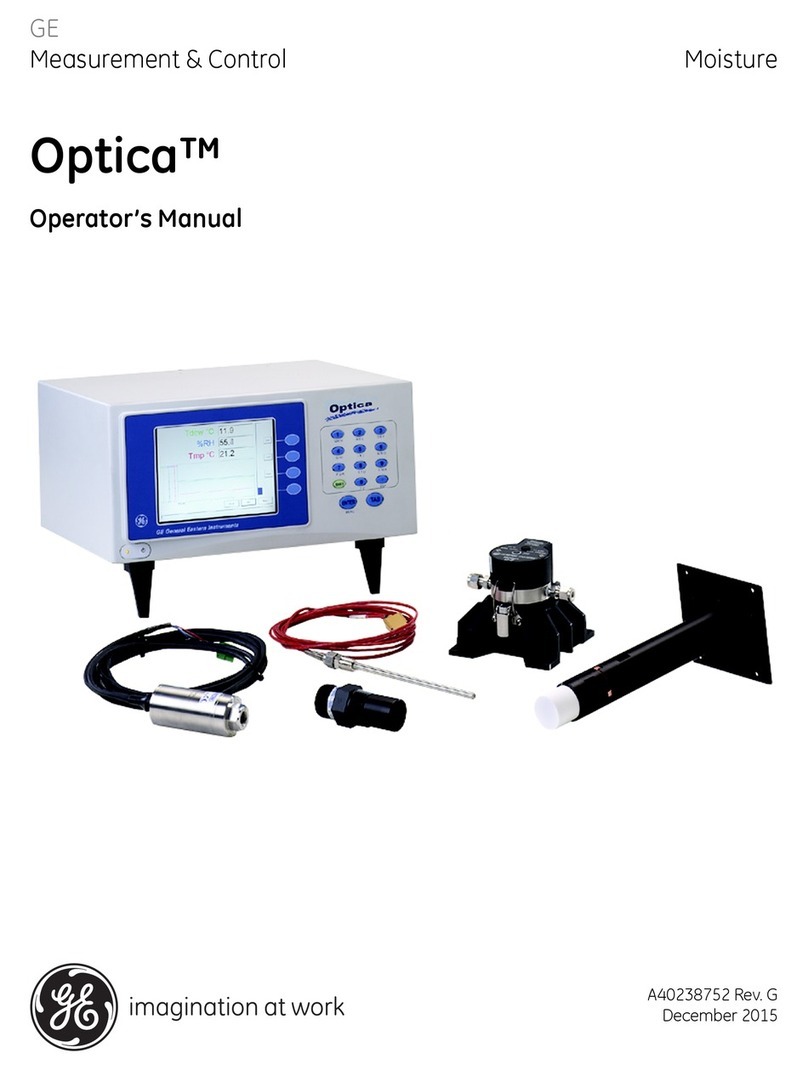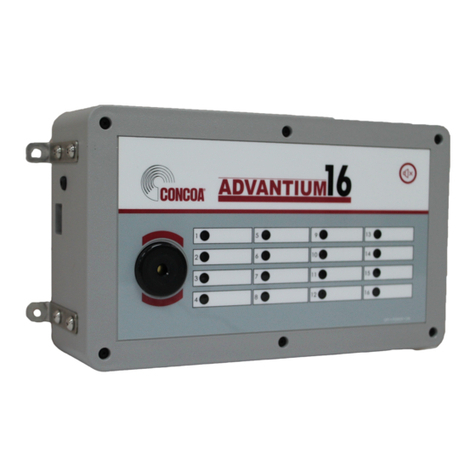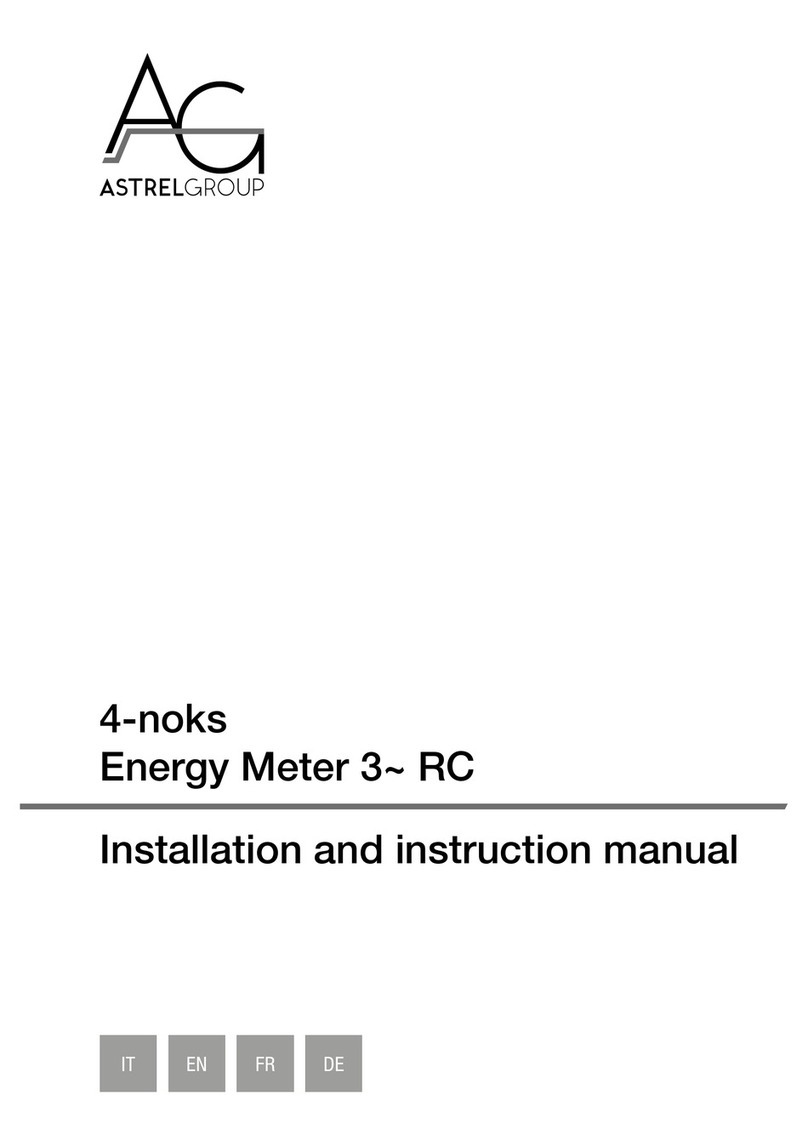Flomotion Systems EM6100 User manual

EM6100
Portable Handheld Ultrasonic Flow Meter

EM6100 Handheld Portable Ultrasonic Flowmeter Ver.8.08
Flomotion Systems, Inc. EM6100 2

EM6100 Handheld Portable Ultrasonic Flowmeter Ver.8.08
Flomotion Systems, Inc. EM6100 3
EM6100
Portable Handheld
Ultrasonic Transit-Time Flow Meter
DECEMBER 2010
Flomotion Systems, Inc.
165 Creekside Drive, Suite 112, Buffalo, NY 14228-2103
Toll Free: (800) 909-3569
Tel: (716) 691-3941 Fax: (716) 691-1253
www.FlomotionSystems.com

EM6100 Handheld Portable Ultrasonic Flowmeter Ver.8.08
Flomotion Systems, Inc. EM6100 4
Table of Contents
1. Introduction ............................................................................................................................................ 6
§1.1 Preface............................................................................................................................................ 6
§1.2 Features .......................................................................................................................................... 6
§1.3 Principle of Measurement .............................................................................................................. 7
§1.4 Parts Identification ......................................................................................................................... 8
§1.5 Typical Applications..................................................................................................................... 10
§1.6 Data Integrity and Built-in Time-Keeper ..................................................................................... 10
§1.7 Product Identification ................................................................................................................... 11
§1.8 Specifications ............................................................................................................................... 11
2. Starting Measurement........................................................................................................................... 12
§2.1 Built-in Battery............................................................................................................................. 12
§2.2 Power On...................................................................................................................................... 12
§2.3 Keypad ......................................................................................................................................... 13
§2.4 Menu Windows ............................................................................................................................ 14
§2.5 Menu Windows Arrangement....................................................................................................... 15
§2.6 Steps to Configure the Parameters ............................................................................................... 15
§2.7 Transducers Mounting Location................................................................................................... 17
§2.8 Transducers Installation................................................................................................................ 19
§2.8.1 Transducers Spacing.............................................................................................................. 19
§2.8.2 V-method Installation ............................................................................................................ 20
§2.8.3 Z-method Installation ............................................................................................................ 20
§2.8.4 W-method Installation ........................................................................................................... 21
§2.9 Installation Checkup..................................................................................................................... 22
§2.9.1 Signal Strength ...................................................................................................................... 22
§2.9.2 Signal Quality........................................................................................................................ 22
§2.9.3 Total Transit Time and Delta Time ........................................................................................22
§2.9.4 Time Ratio between the Measured Total Transit Time and the Calculated Time .................. 23
3. How To................................................................................................................................................. 24
§3.1 How to judge if the instrument is working properly .................................................................... 24
§3.2 How to judge the liquid flow direction......................................................................................... 24
§3.3 How to change between units systems ......................................................................................... 24
§3.4 How to select a required flow rate unit ........................................................................................ 24
§3.5 How to use the totalizer multiplier ............................................................................................... 24
§3.6 How to start or stop the totalizers................................................................................................. 25
§3.7 How to reset the totalizers ............................................................................................................ 25
§3.8 How to restore the flow meter with default setups....................................................................... 25
§3.9 How to use damping..................................................................................................................... 25
§3.10 How to use the zero-cutoff function........................................................................................... 25

EM6100 Handheld Portable Ultrasonic Flowmeter Ver.8.08
Flomotion Systems, Inc. EM6100 5
§3.11 How to setup a zero point........................................................................................................... 25
§3.12 How to get a scale factor for calibration .................................................................................... 26
§3.13 How to use the operation lock.................................................................................................... 26
§3.14 How to use the built-in data logger ............................................................................................ 26
§3.15 How to use the Frequency Output.............................................................................................. 26
§3.16 How to use the Totalizer Pulse Output ....................................................................................... 27
§3.17 How to produce an alarm signal................................................................................................. 27
§3.18 How to use the built-in Buzzer................................................................................................... 28
§3.19 How to use the OCT output........................................................................................................ 28
§3.20 How to modify the built-in calendar .......................................................................................... 28
§3.21 How to adjust the LCD contrast ................................................................................................. 28
§3.22 How to use the RS232 serial interface ....................................................................................... 28
§3.23 How to view the Date Totalizers ................................................................................................ 29
§3.24 How to use the Working Timer................................................................................................... 29
§3.25 How to use the manual totalizer ................................................................................................. 29
§3.26 How to check the ESN and other minor details.......................................................................... 29
§3.27 How to know how long the battery will last............................................................................... 29
§3.28 How to charge the built-in battery.............................................................................................. 29
4. Menu Window Details.......................................................................................................................... 30
5.Troubleshooting..................................................................................................................................... 35
§5.1 Power-on Error Displays and Counter-Measures ......................................................................... 35
§5.2 Error Codes, Causes and Solutions .............................................................................................. 35
§5.3 Other Problems and Solutions...................................................................................................... 37
6. Communication Protocol...................................................................................................................... 38
§6. 0 General ........................................................................................................................................ 38
§6.1 Interface Pin-out Definition.......................................................................................................... 38
§6.2 the Protocol .................................................................................................................................. 39
§6.3 Protocol Prefix Usage................................................................................................................... 40
§6.4 Codes for the Keypad................................................................................................................... 41
7. Warranty and Service ........................................................................................................................... 42
§7.1 Warranty ....................................................................................................................................... 42
§7.2 Service.......................................................................................................................................... 42
§7.2 Software Upgrade Service............................................................................................................ 42

EM6100 Handheld Portable Ultrasonic Flowmeter Ver.8.08
Flomotion Systems, Inc. EM6100 6
1. Introduction
§1.1 Preface
The EM6100 (Version 8.xx) series ultrasonic flow meter that has been manufactured with patented
technologies and is equipped with more functions and advanced performance than our previous versions.
The Version 8.xx series ultrasonic flow meter has been upgraded based on the Version 7.xx series
ultrasonic flow meter, which is still the main product line of the company. The new Version 8.xx retains
most of the features and functions of the previous versions: the pulse measurement technology, the
ultrasonic igniting and the small signal receiving circuits etc. The main improvements are made on the
battery supply circuit and on the transmitting circuits.
The EM6100 Series flow meter features ease of operation, high accuracy and outstanding reliability,
while the software provides a very user friendly interface and many more functions. It employs a
patented balanced lower voltage multi-pulse igniting circuit which increases the anti-interference ability
so that the flow meter will work properly even in demanding industrial environments such as those with
power frequency transformers working nearby.
Other outstanding features:
---- signal receiving circuits feature self-adapting performance so as to ensure that the user can easily
operate the instrument without any adjustment.
---- built-in rechargeable Ni-H battery can work continuously for more than 12 hours without recharge.
§1.2 Features
*0.5%oflinearity
* 0.2% of repeatability
* 4 flow totalizers
* Patent balanced lower-voltage multi-pulse ultrasonic igniting
* built-in date totalizers
* built-in data-logger
* Work properly near transformers
* 0.5 second totalizing period
* 100 Pico-second resolution of time measurement

EM6100 Handheld Portable Ultrasonic Flowmeter Ver.8.08
Flomotion Systems, Inc. EM6100 7
§1.3 Principle of Measurement
The EM6100 ultrasonic flow meter is designed to measure the fluid velocity of liquid within a closed
conduit. The transducers are a non-contacting, clamp-on type, which will provide benefits of
non-fouling operation and easy installation.
The EM6100 transit time flow meter utilizes two transducers that function as both ultrasonic
transmitters and receivers. The transducers are clamped on the outside of a closed pipe at a specific
distance from each other. The transducers can be mounted in V-method where the sound transverses
the pipe twice, or W-method where the sound transverses the pipe four times, or in Z-method where the
transducers are mounted on opposite sides of the pipe and the sound crosses the pipe once. This
selection of the mounting method depends on pipe and liquid characteristics. The flow meter operates
by alternately transmitting and receiving a frequency modulated burst of sound energy between the two
transducers and measuring the transit time that it takes for sound to travel between the two transducers.
The difference in the transit time measured is directly and exactly related to the velocity of the liquid in
the pipe, as shown in Figure 1.
Where
θis the include angle to the flow direction
M is the travel times of the ultrasonic beam
D is the pipe diameter
Tup is the time for the beam from upstream transducer to the downstream one
Tdown is the time for the beam from downstream transducer to the upstream one
ΔT=Tup –Tdown

EM6100 Handheld Portable Ultrasonic Flowmeter Ver.8.08
Flomotion Systems, Inc. EM6100 8
§1.4 Parts Identification
Converter:

EM6100 Handheld Portable Ultrasonic Flowmeter Ver.8.08
Flomotion Systems, Inc. EM6100 9

EM6100 Handheld Portable Ultrasonic Flowmeter Ver.8.08
Flomotion Systems, Inc. EM6100 10
§1.5 Typical Applications
The EM6100 flow meter can be applied to a wide range of measurements. The measured pipe range is
0.75 - 120 inch. A variety of liquid applications can be accommodated: ultra-pure liquids, potable water,
chemicals, raw sewage, reclaimed water, cooling water, river water, plant effluent, etc. Because the
instrument and transducers are non-contacting and have no moving parts, the flow meter can not be
affected by system pressure, fouling or wear. Standard transducers are rated to 230 ºF (110 ºC.) Higher
temperatures can be accommodated. For further information, please consult the manufacturer for
assistance.
§1.6 Data Integrity and Built-in Time-Keeper
All user-inputted configuration values are retained in the built-in non-volatile flash memory that can
store them for over 100 years, even if power is lost or turned off. Password protection is provided to
avoid inadvertent configuration changes or totalizer resets. A time-keeper is integrated in the flow
meter for the index of date totalizing and works as the time base of flow accumulation. It keeps
operating as long as the battery’s terminal voltage is over 1.5V. In case of battery failure, the
time-keeper will not keep running and it will lose proper time values. The user must re-enter proper time
values in case the battery becomes totally exhausted. An improper time value affects no other functions
but the date totalizer.

EM6100 Handheld Portable Ultrasonic Flowmeter Ver.8.08
Flomotion Systems, Inc. EM6100 11
§1.7 Product Identification
Each EM6100 Series flow meter has a unique product identification or ESN written into the software
that can only be modified with a special tool by the manufacturer. In case of any hardware failure, please
provide this number which is located on menu window number M61 when contacting the manufacturer.
§1.8 Specifications
Linearity 0.5%
Repeatability 0.2%
Accuracy ±1% of reading at rates > 0.66 fps (0.2 mps)
Response Time 0-999 seconds, user-configurable
Velocity -53 to +53 fps
Pipe Size 0.75 in – 120 in
Rate Units
Meter, Feet, Cubic Meter, Liter, Cubic Feet, USA Gallon, Imperial
Gallon, Oil Barrel, USA Liquid Barrel, Imperial Liquid Barrel, Million
USA Gallons. User configurable.
Totalizer 7-digit totals for net, positive and negative flow respectively
Liquid Types Virtually all liquids
Security Setup values Modification Lockout. Access code needs unlocking
Display Alphanumeric 4x16 character, back-lit LCD
Communication
Interface
RS-232C, baud-rate: from 75 to 57600. Protocol made by the
manufacturer and compatible with that of the FUJI ultrasonic flow
meter. User protocols can be made on enquiry.
Transducers S, M, L (M standard)
Transducer Cord Length Standard 2x16 ft
Power Supply
3 AAA Ni-H built-in batteries. When fully recharged it will last over
10 hours of operation.
100V-240VAC for the charger
Data Logger Built-in data logger can store over 2000 lines of data
Manual Totalizer 7-digit press-key-to-go totalizer for calibration

EM6100 Handheld Portable Ultrasonic Flowmeter Ver.8.08
Flomotion Systems, Inc. EM6100 12
Housing Material ABS
Case Size 3.4 x 2.6 x 0.79in
Handset Weight 1.2 lbs. with batteries
2. Starting Measurement
§2.1 Built-in Battery
The instrument can operate either from the built-in Ni-H rechargeable battery, which will last over 10
hours of continuous operation when fully recharged, or from an external AC power supply from the
battery charger.
The battery charging circuits employ a scheme of constant-current and constant-voltage. It has a
characteristic of fast charging at the beginning and very slow charging when the battery approaches to
full recharge. Generally, when the green LED starts coming on, the battery would be nearly 95%
recharged and when the red LED is off, the battery would be 98% recharged.
Since the charging current becomes tapered when the battery recharge is nearly completed, i.e. the
charging current becomes smaller and smaller, therefore, there should be no over-recharging problem.
That means the charging progress can last very long. The charger can be connected to the handset all the
time when an around-the-clock measurement is required.
When fully recharged, the terminal voltage reaches around 4.25V. The terminal voltage is displayed on
window M07. When the battery is nearly consumed, the battery voltage drops to below 3V. The user can
obtain an approximate battery working time from the battery voltage. A software battery working time
estimator is integrated in this instrument based on the terminal voltage. Please note that the estimator
may have relatively bigger errors in the estimated working time, especially when the voltage is in the
range of around 3.70 to -3.90 volt.
§2.2 Power On
Press the ON key to switch on the instrument and press the OFF to turn off the power. Once the flow
meter is switched on, it will run a self diagnostic program, checking first the hardware and then the
software integrity. If there is any abnormality, corresponding error messages will display.
Generally, there should be no display of error messages, and the flow meter will go to the most

EM6100 Handheld Portable Ultrasonic Flowmeter Ver.8.08
Flomotion Systems, Inc. EM6100 13
commonly used Menu Window Number 01 (short for M01) to display the Velocity, Flow Rate, Positive
Totalizer, Signal Strength and Signal Quality, based on the pipe parameters configured last time by the
user or by the initial program.
The flow measurement program always operates in the background of the user interface. This means the
flow measurement will keep on running regardless of any user menu window browsing or viewing. Only
when the user enters new pipe parameters will the flow meter change measurement to the new parameter
changes.
When new pipe parameters have been entered or when the power has been just switched on, the flow
meter will enter an adjusting mode to fine tune the proper amplification. By this step, the flow meter is
going to find the best threshold of receiving signal. The user will see the progress by the number 1, 2, or
3, which are indicated on the right lower corner of the LCD display.
When the transducers have been adjusted on the pipe by the user, the flow meter will re-adjust the signal
automatically. Any user-entered configuration value will be retained into the NVRAM of the flow
meter, until it is modified by the user.
§2.3 Keypad
The keypad for the operation of the flow meter has 16+2 keys, as shown by the right diagram.
Keys 0 ~ 9 and . are keys to enter numbers
Key ▲/+ is the UP key, when the user wants to go to the upper menu
window. It also works as + key when entering numbers
Key ▼/- is the DOWN key, when the user wants to go down-sided
menu window. It also works as the ‘–‘ key when entering numbers.
Key ◄is backspace key, when the user wants
go left or wants backspace the left character that
is located to the left of the cursor.
Key ENT is the ENTER key for any inputting or selections.
Key MENU is the key for the direct menu window jump over. Whenever
the user wants to proceed to a certain menu window, the user can press
this key followed by 2-digit numbers.
The MENU key is shortened as the ‘M’ key afterward when referring to the menu windows.
The ON key is for the power on.
The OFF key is for the power off.
ENT
CHARGE
MENU
0
4
7
123
5
8
6
9
ON OFF

EM6100 Handheld Portable Ultrasonic Flowmeter Ver.8.08
Flomotion Systems, Inc. EM6100 14
§2.4 Menu Windows
The user interface of this flow meter comprises about 100 different menu windows that are numbered by
M00, M01, M02 … M99.
There are 2 methods to enter certain menu window:
(1) Direct going/entering. The user can press the MENU key followed by two-digit number keys. For
example, the menu window M11 is for the entering of pipe outer diameter. The display will go to the
M11 menu window after the user presses MENU 1 1
(2) Pressing ▲/+ and ▼/- keys. Each time of the ▲/+ key pressing will proceed to the
lower-numbered menu window. For example, if the current window is on M12, the display will go to the
number M11 window after pressing the ▲/+ key.
There are three different types of menu windows:
(1) Menu windows for number entering, like M11 for the entering of pipe outer diameter.
(2) Menu windows for option selection/selecting options, like M14 for the selection of pipe materials.
(3) Displaying windows only, like M00 to display Velocity, Flow Rate etc.
For number-entering windows, the user can directly press the starting digit key when the user is going to
modify the value. For example, when the current window is on M11, and the user is going to enter
219.2345 as the pipe outer diameter, the user can get the numbers entered by pressing the following
serial keys: 2 1 9 . 2 3 4 5 ENT.
For the option selection windows, the user should first press the ENT key to a selection modification
mode and then select the relevant options by pressing the ▲/+ and ▼/- keys or the digit keys to
select the option with a number antecedent to the option. In the end, the ENT key must be pressed to
make the selection. For example, with menu window M14 for the selection of pipe material selection,
(the MENU 1 4 should be pressed first to enter this menu window if the current menu window is
on a different window. The pipe material is stainless steel which has a number “1” antecedent to
“stainless steel” on the display, the user should first press the ENT key to enter into a selection
modification mode, then either make the selection by pressing the ▲/+ and ▼/- keys to make the cursor
on the line that displays “1. Stainless Steel”, or make the selection by pressing the 1 key directly.
Generally, the ENT key must be pressed to enter a modification mode. If the “Locked M47 Open’
message is indicated on the lowest line of the LCD display, it means the modification operations is
locked out. In such cases, the user should go to M47 to have the instrument unlocked first before any
further modification can be made.

EM6100 Handheld Portable Ultrasonic Flowmeter Ver.8.08
Flomotion Systems, Inc. EM6100 15
§2.5 Menu Windows Arrangement
M00~M09 windows for the display of the flow rate, velocity, date time, totalizers, battery voltage and
estimated working hours for the battery.
M10~M29 windows for entering the pipe parameter.
M30~M38 windows for flow rate unit selections and totalizer unit selections.
M40~M49 windows for response time, zeroing, calibration and modification password setup. M50~M53
windows for the built-in logger
M60-M78 windows for time-keeper initialization, version and ESN information viewing and alarms.
M82 window for viewing date totalizer.
M90~M94 are diagnostic windows for a more accurate measurement.
M97~M99 are not windows but commands for the outputting of display copying and pipe parameter
setups.
M+0~M+8 are windows for some additional functions, including a scientific calculator, viewer on
records such as total working hours, turn-on and turn-off times, dates and times when the flow meter has
been turned on or turned off.
Other menu windows such as M88 have no functions, or functions were cancelled because they are not
applied to this version of the software.
The major reason why the menu windows are arranged in this way is that the software programmer
hopes that the menu window arrangement for this version has the highest compatibility with the
previous versions of the flow meter software. This will make it easier for the former version users with
this flow meter series.
§2.6 Steps to Configure the Parameters
The following parameters need to be configured for a proper measurement:
(1) Pipe outer diameter
(2) Pipe wall thickness
(3) Pipe materials (for non-standard pipe materials*, the sound speed for the material must be
configured too)
*Standard pipe materials and standard liquids refer to those with the sound parameters that have already
been programmed into software of the flow meter, therefore there is no need to configure them
(4) Liner material and its sound speed and thickness, if there is any liner.
(5) Liquid type (for non-standard liquids, the sound speed of the liquid is also needed)
(6) Transducer type adapted to the flow meter. Generally the Standard M1 or the Frame M-sized
transducers will be the selected option.
(7) Transducer mounting methods (the V-method or Z-method is the common option)
(8) Check up the Space displayed on M25 and install the transducers accordingly.
For standard pipe materials and standard liquids, the following detailed step-by-step setup is
recommended.

EM6100 Handheld Portable Ultrasonic Flowmeter Ver.8.08
Flomotion Systems, Inc. EM6100 16
(1) Press keys MENU 1 1 to enter M11 window to input the digits for the pipe outerdiameter,
and then press ENT key.
(2) Press key ▼/- to enter M12 window to input the digits for the pipe outer diameter and then press
ENT key.
(3) Press key ▼/- to enter M14 window, and press ENT key to enter the option selection mode. Use
keys ▲/+ and ▼/- to scroll up and down to the intended pipe material, and then press ENT key.
(4) Press key ▼/- to enter M16 window, press ENT key to enter the option selection mode, use keys
▲/+ and ▼/- to scroll up and down to the liner material, and then press ENT key. Select “No
Liner”, if there is no liner.
(5) Press key ▼/- to enter M20 window, press ENT key to enter the option selection mode, use keys
▲/+ and ▼/- to scroll up and down to the proper liquid, and then press ENT key.
(6) Press key ▼/- to enter M23 window, press ENT key to enter the option selection mode, use
keys ▲/+ and ▼/- to scroll up and down to the proper transducer type, and then press ENT
key.
(7) Press key ▼/- to enter M24 window, press ENT key to enter the option selection mode, use
keys ▲/+and ▼/- to scroll up and down to the proper transducer mounting method, and then press
ENT key.
(8) Press key ▼/- to enter M24 window to install the transducers on the pipe, and then press ENT
key to go to M01 for the results.
The first-time users may need some time to get familiar with the operation. However, the user friendly
interface of the instrument makes the operation quite easy and simple. Before long, the user will
configure the instrument with very little key pressing, since the interface allows the user to go to the
desired operation directly without any extra steps.
The following tips will facilitate the operation of this instrument.
(1) When the window display is between M00 to M09, press a number key x , the user will go directly to
the M0x window. For example, if the current window displays M01, press 7 and the user will go to M07.
(2) When the window display is under M00 to M09, press the ENT key and the user will go to M90;
press ENT key to return. Press the dot key to go to M11
When the window display is under M25, press ENT key to go to M01.

EM6100 Handheld Portable Ultrasonic Flowmeter Ver.8.08
Flomotion Systems, Inc. EM6100 17
§2.7 Transducers Mounting Location
The first step in the installation process is the selection of an optimum location in order to obtain a more
accurate measurement. For this to be completed effectively, a basic knowledge about the piping and its
plumbing system would be advisable.
An optimum location would be defined as a straight pipe length full of liquid that is to be measured. The
piping can be in vertical or horizontal position.
The following table shows examples of optimum locations.
Principles to selection of an optimum location
(1) Install the transducers on a longer length of the straight pipe. The longer the better, and make sure
that the pipe is completely full of liquid.
(2) Make sure that the temperature on the location does not exceed the range for the transducers.

EM6100 Handheld Portable Ultrasonic Flowmeter Ver.8.08
Flomotion Systems, Inc. EM6100 18
Generally speaking, the closer to the room temperature, the better.
(3) Take the pipe fouling into consideration. Select a straight length of a relatively newer pipe. If the
condition is not satisfying, consider the fouling thickness as part of the liner for a better result.
(4) Some pipes have a kind of plastic liner, and between the outer pipe and the liner there may be a
certain thickness difference that will prevent the ultrasonic waves from direct traveling. Such conditions
will make the measurement very difficult. Whenever possible, try to avoid this kind of pipes. If
impossible, try our plug-in transducers that are installed permanently on the pipe by drilling holes on the
pipe while liquid is running inside.

EM6100 Handheld Portable Ultrasonic Flowmeter Ver.8.08
Flomotion Systems, Inc. EM6100 19
§2.8 Transducers Installation
The transducers used by the EM6100 series ultrasonic flow meter are made of piezoelectric crystals both
for transmitting and receiving ultrasonic signals through the wall of liquid piping system. The
measurement is realized by measuring the traveling time difference of the ultrasonic signals. Since the
difference is very small, the spacing and the alignment of the transducers are critical factors to the
accuracy of the measurement and the performance of the system. Meticulous care should be taken for
the installation of the transducers.
Steps for installation of the transducers
(1) Locate an optimum position where the straight pipe length is sufficient, and where pipes are in a
favorable condition, e.g., newer pipes with no rust and ease of operation.
(2) Clean any dust and rust. For a better result, polishing the pipe with a sander is strongly recommended.
(3) Apply adequate coupler to the spot where the transducers are to be installed and leave no gap
between the pipe surface and the transducers.
Extra care should be taken to avoid any sand or dust particles left between the pipe outer surface and the
transducers.
To avoid gas bubbles inside the upper part of the pipe, the transducers should be installed
horizontally by the side of the pipe.
§2.8.1 Transducers Spacing
The spacing value shown on menu window M25 refers to the distance of inner spacing between the two
transducers. The actual transducers spacing should be as close as possible to the spacing value.

EM6100 Handheld Portable Ultrasonic Flowmeter Ver.8.08
Flomotion Systems, Inc. EM6100 20
§2.8.2 V-method Installation
V-method installation is the most widely used mode for daily measurement with pipe inner diameters
ranging from 0.75 in. to 12 in. It is also called reflective mode or method.
§2.8.3 Z-method Installation
Z-method is commonly used when the pipe diameter is between 12 in. and 120 in.
Table of contents
Other Flomotion Systems Measuring Instrument manuals
Popular Measuring Instrument manuals by other brands
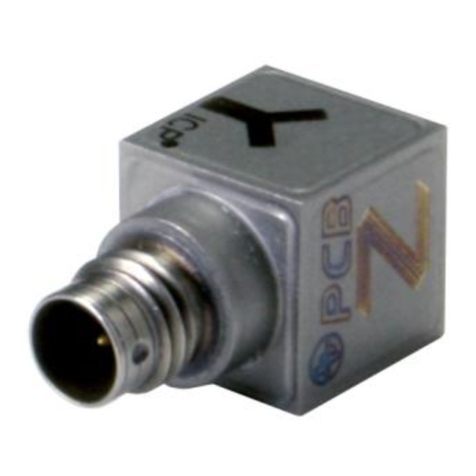
PCB Piezotronics
PCB Piezotronics 356A43 Installation and operating manual

MIR
MIR SMARTONE user manual
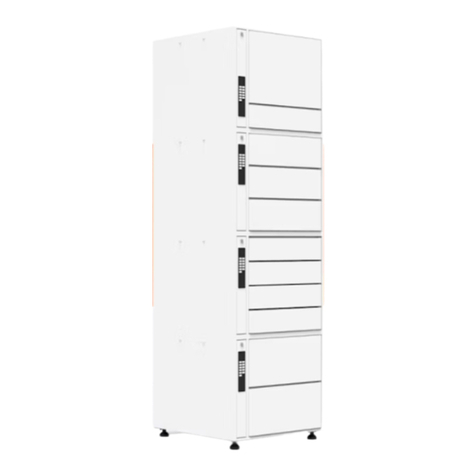
quadient
quadient Parcel Pending Lite Hardware installation guide
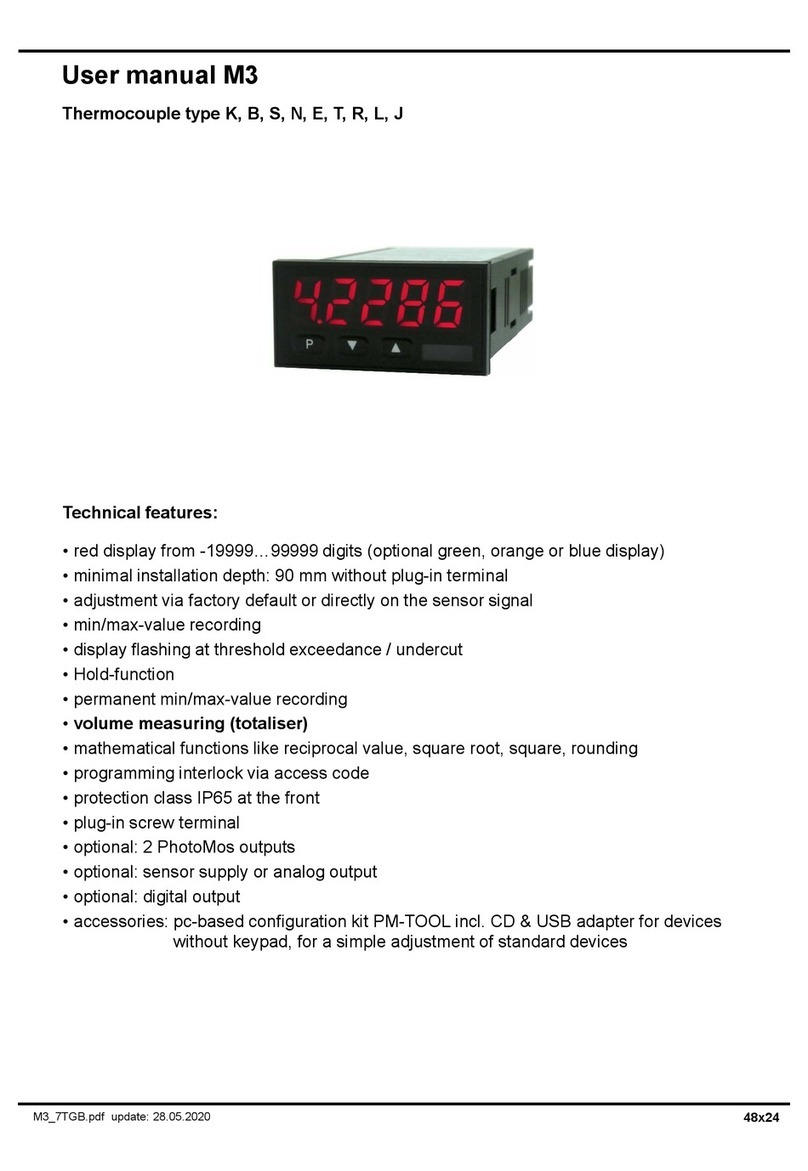
montwill
montwill M3 Series user manual
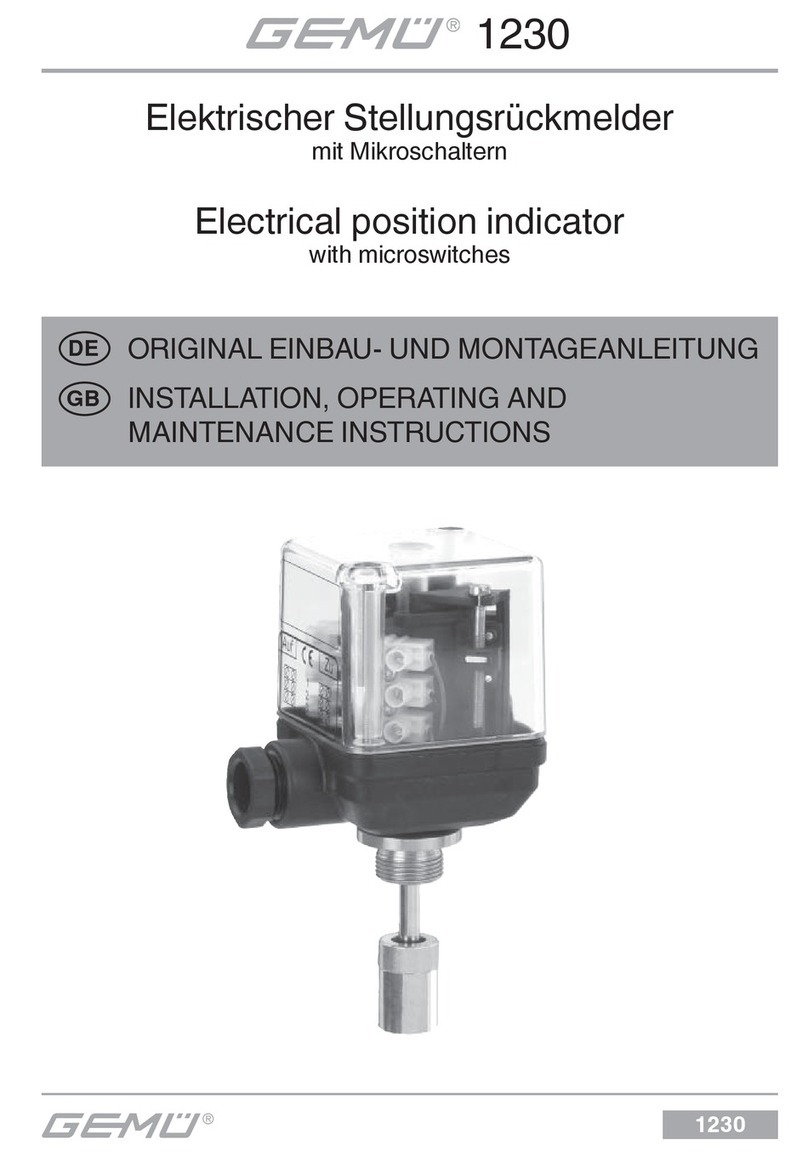
GEM
GEM 1230 Installation, operating and maintenance instructions
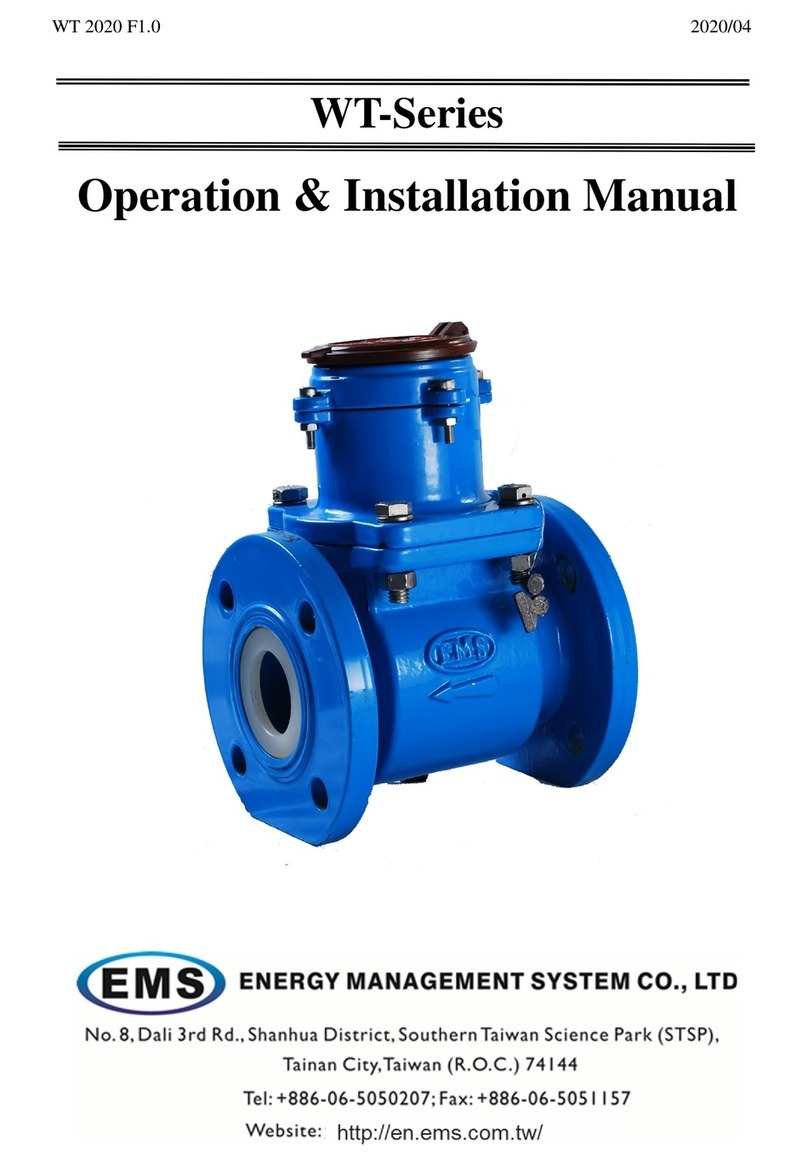
EMS
EMS WT Series Operation & installation manual
